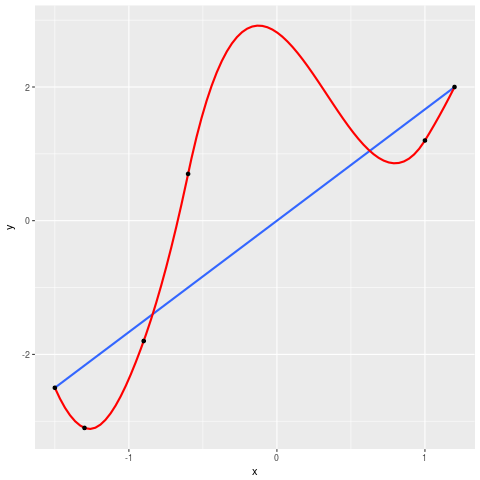Model validation, model fit, and prediction
Machine Learning for Marketing Analytics in R

Verena Pflieger
Data Scientist at INWT Statistics
Coefficient of Determination $R^2$

$R^2$ and F-test
summary(multipleLM2)
Residual standard error: 13.87 on 4179 degrees of freedom
Multiple R-squared: 0.3522, Adjusted R-squared: 0.3504
F-statistic: 206.5 on 11 and 4179 DF, p-value: < 2.2e-16
Overfitting

Methods to avoid overfitting
AIC()fromstatspackagestepAIC()fromMASSpackage- Out-of-sample model validation
- Cross-validation
- ...
AIC(multipleLM2)
33950.45
New dataset clvData2
head(clvData2)
# A tibble: 6 x 14
customerID nOrders nItems daysSinceLastOrder margin returnRatio
<int> <int> <int> <int> <dbl> <dbl>
1 2 16 40 2 57.62 0.18
2 3 1 5 124 29.69 1.00
3 4 15 30 68 56.26 0.16
4 5 23 41 103 58.84 0.03
5 6 2 4 104 29.31 0.00
6 7 6 10 41 35.72 0.06
#... with 8 more variables: shareOwnBrand <dbl>, shareVoucher <dbl>,
# shareSale <dbl>, gender <chr>, age <int>, marginPerOrder <dbl>,
# marginPerItem <dbl>, itemsPerOrder <dbl>
Prediction
predMargin <- predict(multipleLM2,
newdata = clvData2)
head(predMargin)
1 2 3 4 5 6
51.10204 31.63335 51.90008 52.62200 36.65194 33.84383
mean(predMargin, na.rm = TRUE)
33.95147
Learnings linear regression
| Learnings Linear Regression | |
|---|---|
| You have learned... | to predict the future customer lifetime value |
| to use a linear regression to model a continuous variable | |
| that the variables for modelling and prediction have to carry the same names |
Learnings from the model
| Learnings from the Model | |
|---|---|
| You have learned... | that the margin in one year is a good predictor for the margin in the following year |
| the longer the time since last order, the smaller the expected margin | |
| characteristics like gender and age don't seem to play a role for the prediction of margin | |
| etc... |
Alright, hands on!
Machine Learning for Marketing Analytics in R

